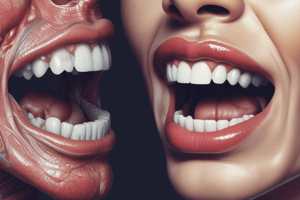Podcast
Questions and Answers
What is the function of the gingival in the mouth?
What is the function of the gingival in the mouth?
- Helping with speech articulation
- Aiding in taste perception
- Producing saliva for digestion
- Surrounding the teeth and covering the jaw bone (correct)
Which part of the mouth contains papillae with taste buds?
Which part of the mouth contains papillae with taste buds?
- Palate
- Teeth
- Tongue (correct)
- Cheeks
What is the function of the lingual frenum?
What is the function of the lingual frenum?
- Anchoring the tongue to the bottom of the mouth (correct)
- Protecting the taste buds
- Producing saliva for digestion
- Helping in chewing food
Where does the gag reflex occur in the mouth?
Where does the gag reflex occur in the mouth?
How many teeth does an adult with a complete set have?
How many teeth does an adult with a complete set have?
What is the composition of the cheeks in the mouth?
What is the composition of the cheeks in the mouth?
What is the primary function of the esophagus?
What is the primary function of the esophagus?
Which of the following is NOT a region of the stomach?
Which of the following is NOT a region of the stomach?
What is the function of the ileocecal valve?
What is the function of the ileocecal valve?
In which region of the large intestine is the appendix located?
In which region of the large intestine is the appendix located?
What is the approximate length of the small intestine in a person?
What is the approximate length of the small intestine in a person?
Which of the following is the correct order of the regions of the large intestine, from proximal to distal?
Which of the following is the correct order of the regions of the large intestine, from proximal to distal?
Study Notes
Mouth (Oral Cavity)
- The mouth, also known as the oral cavity, is the starting point of the digestive tract.
- Components of the oral cavity include teeth, gingival (gums), tongue, palate (hard and soft), and cheeks.
- Children between 2-6 years old have 20 teeth, while adults have a complete set of 32 teeth.
Gingival (Gums)
- The gingival is the soft tissue that surrounds the teeth and covers the jaw bone.
Tongue
- The tongue is a muscular organ attached to the bottom of the mouth by the lingual frenum.
- The top surface of the tongue contains papillae with taste buds.
Palate
- The palate refers to the roof of the mouth, divided into two parts: hard palate and soft palate.
- The hard palate is the solid, immovable area that attaches to the teeth and gums.
- The soft palate is a flexible area located behind the hard palate, where the gag reflex occurs.
Cheeks and Lips
- The cheeks form the sides of the mouth and continue along the front of the face to the lips.
- The cheeks are composed of subcutaneous membrane, with an outside layer of skin and an inside layer of mucous membrane.
- The lips are soft, flexible, fleshy tissue that connect to the front area of the cheeks.
Pharynx
- The pharynx is located behind the mouth and nasal cavity, above the esophagus and larynx.
- The human pharynx is divided into three sections: nasopharynx, oropharynx, and laryngopharynx.
Esophagus
- The esophagus is a hollow muscular tube that transports saliva, liquids, and foods from the mouth to the stomach.
- It is located behind the windpipe (trachea) and heart, passing through the diaphragm before entering the stomach.
- The esophagus is approximately 25-30 cm in length and 1.5-2 cm in width.
Stomach
- The stomach is a muscular organ located on the left side of the upper abdomen.
- It receives food from the esophagus and has four main regions: cardia, fundus, body, and pylorus.
- The cardia is the point where the esophagus connects to the stomach.
- The fundus is a dome-shaped region located above and to the left of the cardia.
- The body is the main part of the stomach.
- The pylorus connects the stomach to the duodenum, controlled by the smooth muscle pyloric sphincter.
Small Intestine
- The small intestine is the longest part of the alimentary canal, approximately 3-4 meters (10-13 feet) long.
- It is divided into three regions: duodenum, jejunum, and ileum.
Large Intestine
- The large intestine is approximately 1.2-1.5 meters in length.
- It begins with a small pouch called the cecum, attached to which is a small blind tube containing lymphoid tissue, called the vermiform appendix.
- The large intestine then extends into the ascending colon, transverse colon, descending colon, sigmoid colon, and finally the rectum, which leads to the outside of the body through the anus.
Studying That Suits You
Use AI to generate personalized quizzes and flashcards to suit your learning preferences.
Description
Test your knowledge about the components of the oral cavity including teeth, gums, tongue, and palate. Learn about the structure and function of 20 deciduous and 32 permanent teeth, as well as the roles of the gingival tissue and tongue.




